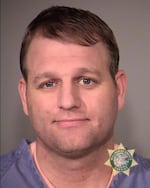
Ammon Bundy, Feb. 24, 2016
Courtesy of the Multnomah County Sheriff's Office
Utah attorney Marcus Mumford is positioning his client, Ammon Bundy, as a political activist who used his words, not weapons, to spread an anti-federalist message through protest, according to new court filings.
But many of Mumford's claims run counter to documented events before and during the occupation earlier this year.
Mumford estimated that more than 1,000 people, including ranchers, politicians, attorneys, federal employees and protesters, traveled to and from the Malheur National Wildlife Refuge without government interference during the occupation.
That’s significant, argued Mumford, because during the 41-day occupation, Ammon and his brother, Ryan Bundy, were never formally asked to leave the federal property. Mumford also claimed the men were not notified of any criminal allegations or arrest warrants until LaVoy Finicum’s Jan. 26 shooting death, when they were taken into federal custody.
That claim does not mention multiple encounters between the Bundys and Harney County Sheriff David Ward and other local leaders, who repeatedly asked the occupation leaders to leave the refuge and return to their homes before Finicum's death.
Related: Complaints Against Former Bundy Lawyer Dismissed
In a 28-page pretrial release request for the Bundy brothers filed Friday, Mumford claimed Ammon Bundy never personally carried a firearm during the occupation. Interviews with Oregon State Police troopers after Bundy was arrested Jan. 26
support that claim, stating he was unarmed during the traffic stop
. However, a sworn affidavit from FBI special agent Katherine Armstrong states that law
enforcement removed a .40 caliber pistol from Bundy
at the time.
It also appears Mumford may be trying to point some responsibility away from Ammon Bundy as a lead organizer, allowing brother Ryan Bundy to shoulder responsibility for the armed takeover.
“Ammon was not among the first group to travel to the Refuge to establish the statutory adverse possession claim, but his brother, Ryan, was,” Mumford wrote in the motion.
Ammon Bundy began meeting with Steven and Dwight Hammond in "late 2015" after reading about them in online publications, according to Mumford. The father-and-son ranchers were sentenced to return to prison for arson.
Related: Why Were The Hammonds Sent Back To Prison?
“These early efforts to raise awareness about the Hammonds’ situation were not tied to any group or organization, as Ammon was not a leader or spokesperson for any group at the time,” Mumford said.
Ammon Bundy may not have directly represented any so-called militia groups, but he didn't discourage their support, encouraging groups to travel to Burns after the occupation began.
"We need you to bring your arms and we need you to come to the Malheur National Wildlife Refuge,” Bundy said in a Jan. 3 video posted online, according to federal prosecutors.
Bundy also traveled to Burns in December 2015 with fellow defendant Ryan Payne, a known leader in western militia groups, to set up a "committee of safety" that was designed to present extrajudicial prosecution against government officials.
The group was comprised of local community members who shared Bundy's ideals and had a goal of limiting federal authority on county land. As the occupation dragged on, however, they increasingly didn't share the occupiers' enthusiasm for taking over a federal building – and ultimately asked the them to leave.
On Jan. 2, Ammon Bundy organized a small meeting where he planned to outline his idea for the occupation.
Related: Key Wildlife Refuge Occupier Scheduled To Plead Guilty
"As to the specifics, Ammon had not developed, shared or decided upon the details of any plan prior to the meeting,” wrote Mumford. “Mr. Bundy and several others present at the meeting had learned that the Malheur refuge was currently unoccupied and that no government employees or officers were present.”
Despite Mumford's claim, refuge employees reported that occupiers had visited the refuge in the months leading up to the occupation.
Mumford's filing also gives a window into a potential defense strategy for Bundy's trial.
He wrote that Ammon Bundy changed the name of the refuge to the "Harney County Resource Center," under the principles of law that apply to statutory adverse possession. Mumford said Ammon Bundy and the occupiers intended to take over the responsibility for the refuge building's utilities, and establish what they viewed to be legitimate control to acquire the federal building.
In a written affidavit filed along with Friday's documents, Bundy asked for his pretrial release, and explains that because the case is so heavily reliant upon digital media evidence, he is disadvantaged behind bars. He and Ryan Bundy have made similar requests for release before and been denied by federal Judge Anna Brown.
Bundy also called for the court to "use its authority to ensure that federal agencies do not manipulate their power, the exposure in this case will bring to light how federal agencies are discrediting and disregarding all three branches’ powers and usurping their powers as their own,” Bundy wrote.
He said during his time behind bars, he’s lost nearly half of his clients at his commercial vehicle maintenance business in Arizona and has lost many employees. Bundy explained that he doesn’t have any reason to flee, and is eager to show the overreach of federal agencies through his case.
A trial is scheduled for Sept. 7.
